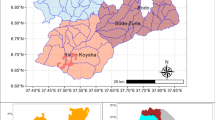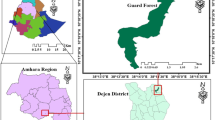Abstract
The aim of this study was to identify habitat preferences of red-listedepiphytic and epixylic bryophyte, lichenized and non-lichenized fungi speciesinwoodland key habitats (WKHS) (areas less than 10 ha, where foreststructures indicate occurrence of red-listed species) in southern Sweden. Therelative importance of different groups of environmental factors was assessedwith partial canonical correspondence analysis techniques and across-validationapproach using data from 7196 selected WKHs. Different woody substrates (oldtrees, logs and snags) made up the most important variable group for occurrenceof red-listed species (30% unique explainable variation). Species associatedwith Fagus sylvatica and Picea abieshabitats, but also species associated with Quercus spp.andPopulus tremula habitats showed distinct habitatpreferences. The second most important variable group (16% unique explainablevariation) was geographical location. A west–east gradient was identified, andspecies concentrated to Baltic islands in the east were separated from otherspecies. This gradient, and an identified south–north gradient, probablyreflect differences in temperatures and rainfall between different regions.Among the remaining variable groups, historical land-use, ground conditions andforest stand composition were of similar importance (5–7% uniqueexplainable variation). Traditional management regimes resulting in semi-openforest habitats (leaf harvesting, forest grazing and selective cutting) wereassociated with the occurrence of many species, probably due to differences inmicroclimate between sites of different openness. Furthermore, a groundmoisturegradient extending from species associated with dry sites (mainly lichenizedfungi) to species associated with wet sites (mainly bryophytes), and a nutrientgradient from species associated with nutrient-poor sites to species occurringat nutrient-rich sites, were identified. Thus, conservation measures are neededin a broad spectrum of habitats with different substrates. Also sites withsimilar substrates, but situated in different regions (and climates), or withdifferent ground moisture and nutrient conditions are needed to cover the fullspectrum of habitat conditions suitable for different red-listed bryophytes andfungi.
Similar content being viewed by others
References
Aronsson M., Hallingbäck T. and Mattson J.-E. 1995. Swedish Red Data Book of Plants 1995. ArtDatabanken, Uppsala, Sweden, in Swedish with English summary.
Berg Å. and Tjernberg M. 1996. Common and rare Swedish vertebrates — distribution and habitat preferences. Biodiversity and Conservation 5: 101–128.
Berg Å., Ehnström B., Gustafsson L., Hallingbäck T., Jonsell M. and Weslien J. 1994. Threatened plant, animal and fungi species in Swedish forests — distribution and habitat associations. Conservation Biology 8: 718–731.
Berg Å., Ehnström B., Gustafsson L., Hallingbäck T., Jonsell M. and Weslien J. 1995. Threat levels and threats to red-listed species in Swedish forests. Conservation Biology 9: 1629–1633.
Berglund B.E., Björse G. and Liljegren R. 1996. From the ice age to the present day. In: Gustafsson L. and Ahlén I. (eds), Geography of Plants and Animals. National Atlas of Sweden. Bra Bocker, Höganäs, Sweden, pp. 14–24.
Bernes C. (ed.) 1994. Biological Diversity in Sweden. A Country Study. Monitor 14. Swedish Environmental Protection Agency, Solna, Sweden.
Ek T., Wadstein M. and Johannesson J. 1995. What is the origin of the lichen flora of old oaks? Svensk Botanisk Tidskrift 89 (in Swedish with English summary): 335–343.
Esseen P.-A., Ehnström B., Ericsson L. and Sjöberg K. 1992. Boreal forests — the focal habitats of Fennoscandia. In: Hansson L. (ed.), Ecological Principles of Nature Conservation. Elsevier, London, pp. 252–325.
Fielding A.H. and Bell J.F. 1997. A review of methods for assessment of prediction errors in conservation presence /absence models. Environmental Conservation 24: 38–49.
Fridman J. 2000. Conservation of forests in Sweden: a strategic ecological analysis. Biological Conservation 96: 95–103.
Fridman J. and Walheim M. 2000. Amount, structure, and dynamics of dead wood on managed forestland in Sweden. Forest Ecology and Management 131: 23–36.
Gauslaa Y. 1995. The Lobarion, an epiphytic community of ancient forests threatened by acid rain. Lichenologist 27: 59–76.
Gauslaa Y., Ohlson M. and Rolstad J. 1998. Fine-scale distribution of the epiphytic lichen Usnea longissima on two even-aged neighbouring Picea abies trees. Journal of Vegetation Science 9: 95–102.
Gärdenfors U. (ed.) 2000. Rödlistade arter i Sverige 2000 — The 2000 Red List of Swedish species. ArtDatabanken, SLU, Uppsala, Sweden.
Gardenfors U. and Baranowski R. 1992. Beetles living in open deciduous forest prefer different tree taxa than those living in dense forests. Entomologisk Tidskrift 113 (in Swedish with English summary): 1–11.
Gustafsson L. 1994. A comparison of biological characteristics and distribution between Swedish threatened and non-threatened forest vascular plants. Ecography 17: 39–49.
Gustafsson L. 1999. Red-listed species and indicators: vascular plants in woodland key habitats and surrounding production forests in Sweden. Biological Conservation 92: 35–43.
Gustafsson L., de Jong J. and Noren M. 1999. Evaluation of Swedish woodland key habitats using red-listed bryophytes and lichens. Biodiversity and Conservation 8: 1101–1114.
Gustafsson L. and Eriksson I. 1995. Factors of importance for the epiphytic vegetation of aspen Populus tremula with special emphasis on bark chemistry and soil chemistry. Journal of Applied Ecology 32: 412–424.
Gustafsson L., Fiskesjö A., Hallingbäck T., Ingelög T. and Pettersson B. 1992. Seminatural deciduous broadleaved woods in southern Sweden — habitat factors of importance for some bryophyte species. Biological Conservation 59: 175–181.
Hallgren E., Palmer M.W. and Milberg P. 1999. Data diving with cross-validation: an investigation of broad-scale gradients in Swedish weed communities. Journal of Ecology 87: 1037–1051.
Hallingbäck T. (ed.) 1998. Swedish Red Data Book of Bryophytes. ArtDatabanken, SLU, Uppsala, Sweden, in Swedish.
Hansson L. (ed.) 1997. Boreal ecosystems and landscapes; structures processes and conservation of biodiversity. Ecological Bulletins 46 (entire volume).
Hansson L., Fahrig L. and Merriam G. (eds) 1995. Mosaic Landscapes and Ecological processes. Chapman & Hall, London.
Jonsell M., Weslien J. and Ehnström B. 1998. Substrate requirements of red-listed saproxylic invertebrates in Sweden. Biodiversity and Conservation 7: 749–764.
Larsson K.-H. (ed.) 1997. Swedish Red Data Book of Fungi. ArtDatabanken, SLU, Uppsala, Sweden, in Swedish.
Legendre P. and Legendre L. 1998. Numerical Ecology. Elsevier, Amsterdam.
McCune B. 1997. Influence of noisy environmental data on canonical correspondence analyses. Ecology 78: 2617–2623.
Moe B. and Botnen A. 1997. A quantitative study of the epiphytic vegetation on pollarded trunks of Fraxinus excelsior at Havrå, Osteroy, western Norway. Plant Ecology 129: 157–177.
National Board of Forestry 1998. The Swedish Woodland Key Habitat Survey 1993–1998. Skogs-styrelsen, Jönköping, Sweden, in Swedish.
Nilsson C. and Götmark F. 1992. Protected areas in Sweden. Is natural variety adequately represented? Conservation Biology 6: 232–242.
Nitare J. and Norén M. 1992. Woodland key-habitats of rare and endangered species mapped in a new project of the Swedish National Board of Forestry. Svensk Botanisk Tidskrift 86 (in Swedish with English summary): 219–226.
Norén M., Hultgren B., Nitare J. and Bergengren I. 1995. Instructions for Censuses of SwedishWoodland Key Habitats. Skogsstyrelsen, Jönköping, Sweden, in Swedish.
Økland R.H. 1999. On the variation explained by ordination and constrained ordination axes. Journal of Vegetation Science 10: 131–136.
Økland R.H. and Eilertsen O. 1994. Canonical correspondence analyses with partitioning: some comments and an application. Journal of Vegetation Science 5: 117–126.
Östlund L., Zackrisson O. and Axelsson A.L. 1997. The history and transformation of a Scandinavian boreal forest landscape since the 19th century. Canadian Journal of Forest Research 27: 1198–1206.
Peck J.E. and McCune B. 1997. Remnant trees and canopy lichen communities in western Oregon: a retrospective approach. Ecological Applications 7: 1181–1187.
Raab B. and Vedin B. (eds) 1995. Climate, Lakes and Rivers. National Atlas of Sweden. Bra Böcker, Höganäs, Sweden.
Roche P., Tatoni T. and Médail F. 1998. Relative importance of abiotic and land-use factors in explaining variation in woody vegetation in a French rural landscape. Journal of Vegetation Science 9: 221–228.
Rosén E. and Borgegård S.-O. 1999. The open cultural landscape. Swedish plant geography. Acta Phytogeographica Suecica 84: 113–134.
Rydin H., Diekmann M. and Hallingbäck T. 1997. Biological characteristics, habitat associations and distribution of macrofungi in Sweden. Conservation Biology 11: 628–640.
Slotte H. 2000. Harvest of leaf-hay in Sweden and Åland. Methods used and impact on landscape, Ph.D. Thesis, Swedish University of Agricultural Sciences, Uppsala, Sweden(in Swedish with English summary).
Statistics Sweden 1999. Statistical Yearbook of Forestry 1999. National Board of Forestry, Jönköping, Sweden.
Tenow O. 1974. Det nordiska skogslandskapets och skogsbrukets utveckling fram till 1900-talet — en kort översikt. Swedish Coniferous Forest Project, Internal Report 2.
ter Braak C.J.F. 1987. The analysis of vegetation-environmental relationships by canonical correspondence analysis. Vegetatio 69: 69–77.
ter Braak C.J.F. and Smilauer P. 1998. CANOCO Reference Manual and User's Guide to CANOCO for Windows: Software for Canonical Community Ordination (version 4). Microcomputer Power, Ithaca, New York, 352 pp.
Thor G. and Arvidsson L. (eds) 1999. Swedish Red Data Book of Lichens. ArtDatabanken, SLU, Uppsala, Sweden.
Thor G. 1998. Red-listed lichens in Sweden: habitats, threats, protection, and indicator value in boreal coniferous forest. Biodiversity and Conservation 7: 59–72.
Author information
Authors and Affiliations
Rights and permissions
About this article
Cite this article
Berg, Å., Gärdenfors, U., Hallingbäck, T. et al. Habitat preferences of red-listed fungi and bryophytes in woodland key habitats in southern Sweden – analyses of data from a national survey. Biodiversity and Conservation 11, 1479–1503 (2002). https://doi.org/10.1023/A:1016271823892
Issue Date:
DOI: https://doi.org/10.1023/A:1016271823892




